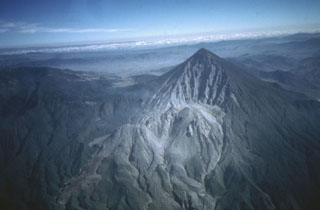Report on Santa Maria (Guatemala) — 4 June-10 June 2014
Smithsonian Institution / US Geological Survey
Weekly Volcanic Activity Report, 4 June-10 June 2014
Managing Editor: Sally Sennert.
Please cite this report as:
Global Volcanism Program, 2014. Report on Santa Maria (Guatemala) (Sennert, S, ed.). Weekly Volcanic Activity Report, 4 June-10 June 2014. Smithsonian Institution and US Geological Survey.
Santa Maria
Guatemala
14.757°N, 91.552°W; summit elev. 3745 m
All times are local (unless otherwise noted)
On 6 June INSIVUMEH reported that the Santiaguito Observatory (OBSAN) was seriously affected by a large lahar that descended the Nima I river drainage on the S flank of Santa María's Santiaguito lava-dome complex. The lahar came in waves, 5-9 m high, was 80 m wide, and carried blocks up to 5 m in diameter. It overtopped the river banks and flowed to a nearby farm. The staff working at OBSAN had to evacuate; some important scientific equipment was lost and damaged. On 7 June a lahar descended the Samala river, a tributary of the Nima I river, carrying blocks up to 1 m in diameter, and lahars in the Nima I drainage had a sulfur odor. During 7-8 June slow-moving lava flows descended the E flank. Explosions during 8-9 June generated ash plumes that rose 500 m and drifted SW. Large avalanches in the collapsed area were incandescent at night. During 9-10 June explosions generated white and gray plumes that rose 500 m, the lava flows on the E flank produced avalanches, and Domo del Brujo began degassing.
Geological Summary. Symmetrical, forest-covered Santa María volcano is part of a chain of large stratovolcanoes that rise above the Pacific coastal plain of Guatemala. The sharp-topped, conical profile is cut on the SW flank by a 1.5-km-wide crater. The oval-shaped crater extends from just below the summit to the lower flank, and was formed during a catastrophic eruption in 1902. The renowned Plinian eruption of 1902 that devastated much of SW Guatemala followed a long repose period after construction of the large basaltic andesite stratovolcano. The massive dacitic Santiaguito lava-dome complex has been growing at the base of the 1902 crater since 1922. Compound dome growth at Santiaguito has occurred episodically from four vents, with activity progressing E towards the most recent, Caliente. Dome growth has been accompanied by almost continuous minor explosions, with periodic lava extrusion, larger explosions, pyroclastic flows, and lahars.
Source: Instituto Nacional de Sismologia, Vulcanologia, Meteorologia, e Hidrologia (INSIVUMEH)

